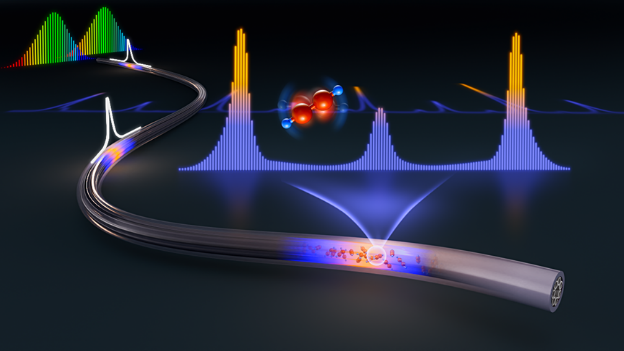The research team of Professor Wei REN has recently demonstrated the world’s first dual-comb photothermal spectroscopy (DC-PTS), a breakthrough in high-precision spectroscopy with proven potential for highly sensitive multi-gas detection from a small sample volume within a millisecond. It opens up a wider application in gas sensing, from the detection of toxic gases to the measurement of chemical compounds in breath samples, such as biochemical markers of COVID-19. The research has been reported in the scientific journal Nature Communications.
Breakthrough in high-precision spectroscopy
Laser absorption spectroscopy is a widely used technique for gas detection, in which the light source applied plays a pivotal role in broadband gas sensing and is the determining factor in its sensing resolution and sensitivity. An optical frequency comb, a special light source emitting numerous evenly spaced and phase-coherent laser lines simultaneously, has been introduced for high-precision spectroscopy. However, conventional frequency comb spectroscopy requires a sophisticated spectrometer or photodetector to resolve the comb line and a bulky gas cell to obtain sufficient sensitivity, limiting its wider applications outside the laboratory.
Professor Wei REN and his collaborator from Changchun Institute of Optics, Fine Mechanics and Physics, China have proposed a novel sensing technique — dual-comb photothermal spectroscopy (DC-PTS) to take gas sensing technology to a new level. When light beams emitted from two coherent frequency combs pass simultaneously through a hollow-core fibre filled with the sample gas, an optical interference between the two combs, also known as the beating process, is induced in the fibre. This unique physical reaction causes the photothermal effect that modifies the refractive index of the sample gas. By measuring the modulations of the refractive index at various frequencies, absorption spectra of the sample gas can be detected precisely to infer the components.
The full research paper can be found at: https://www.nature.com/articles/s41467-022-29865-6

The image demonstrates the beating process that occurs in the hollow-core fibre when the dual-comb light (top left of the image) is transmitted through the gas-filled fibre. The optical interference induced between the two combs further causes the photothermal effect that modifies the refractive index of the sample gas.
CUHK Press Release: Click here!